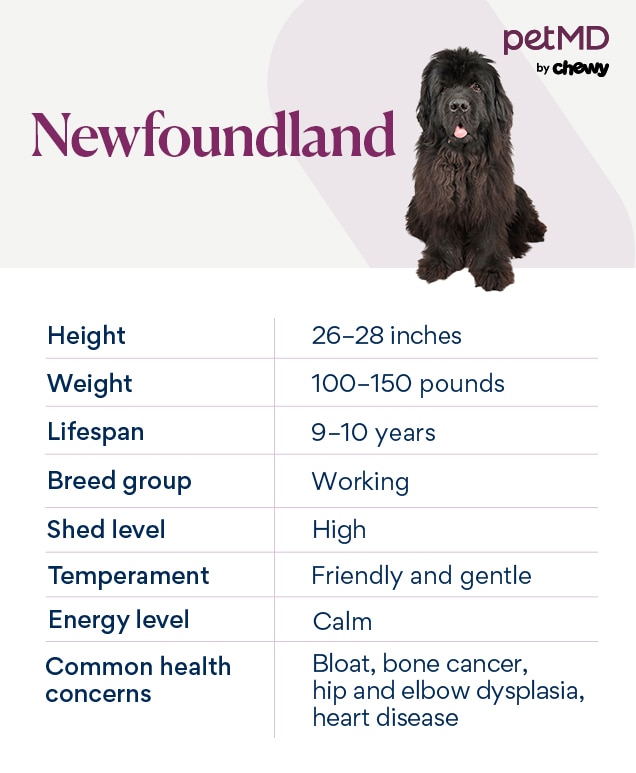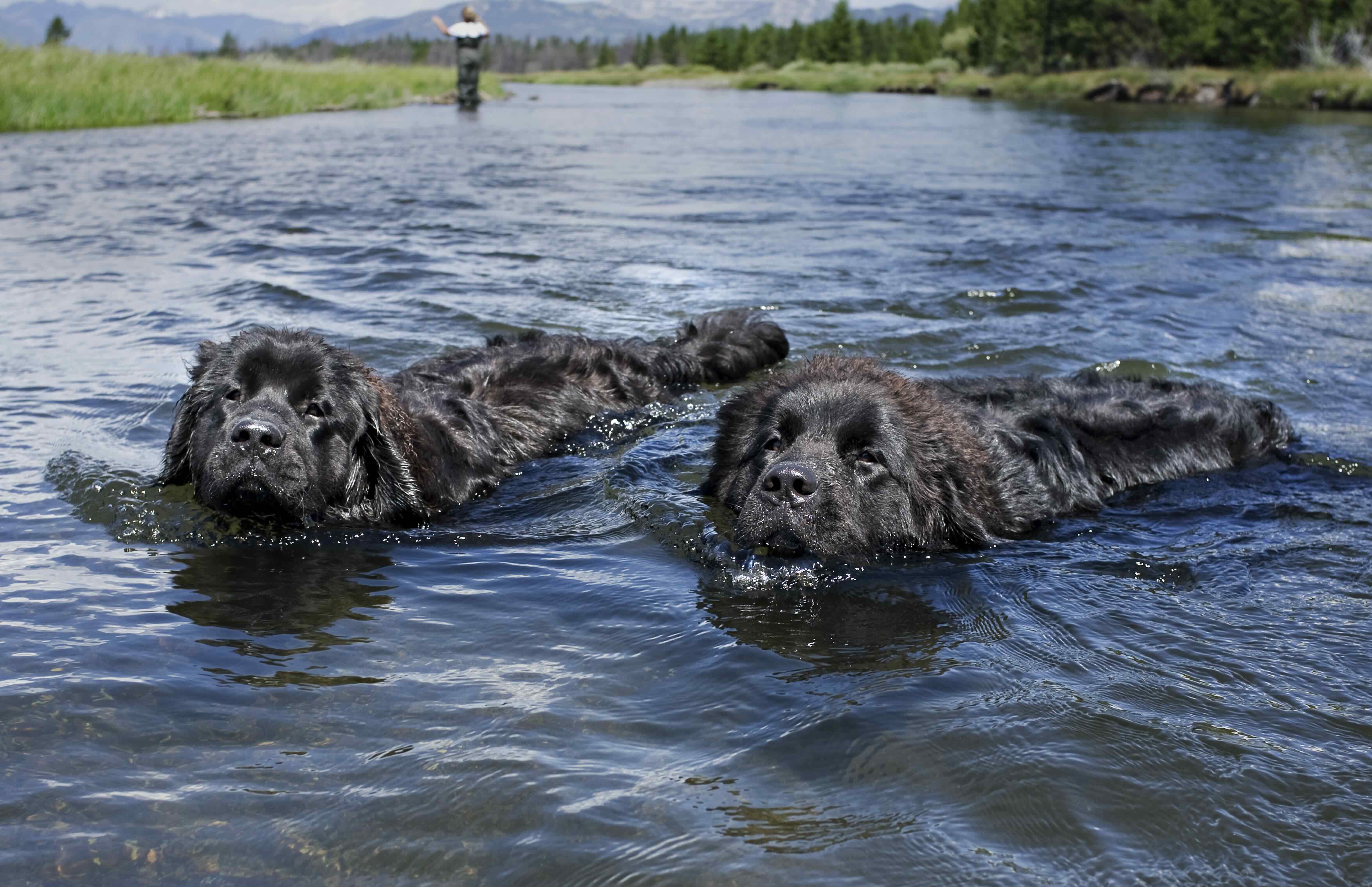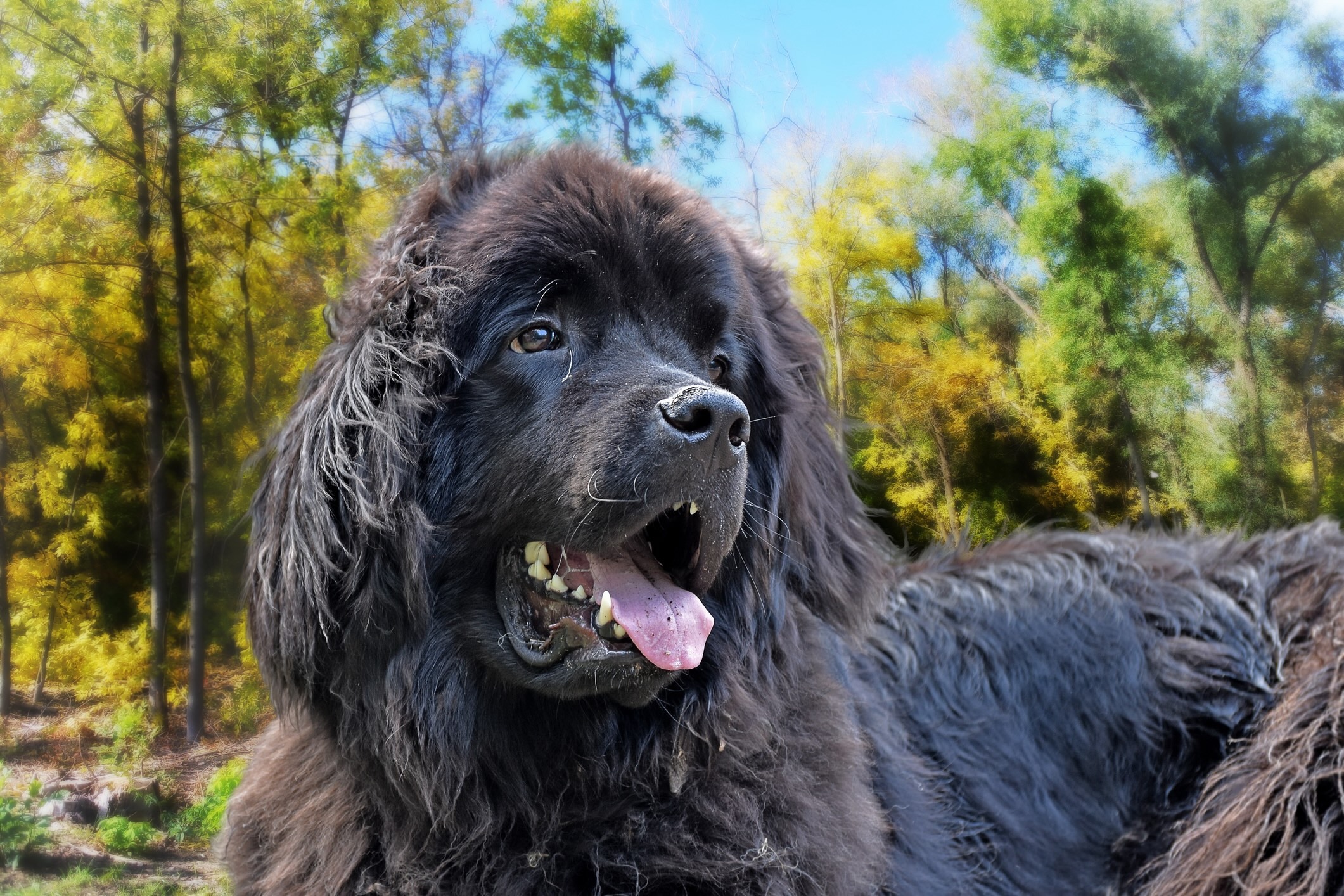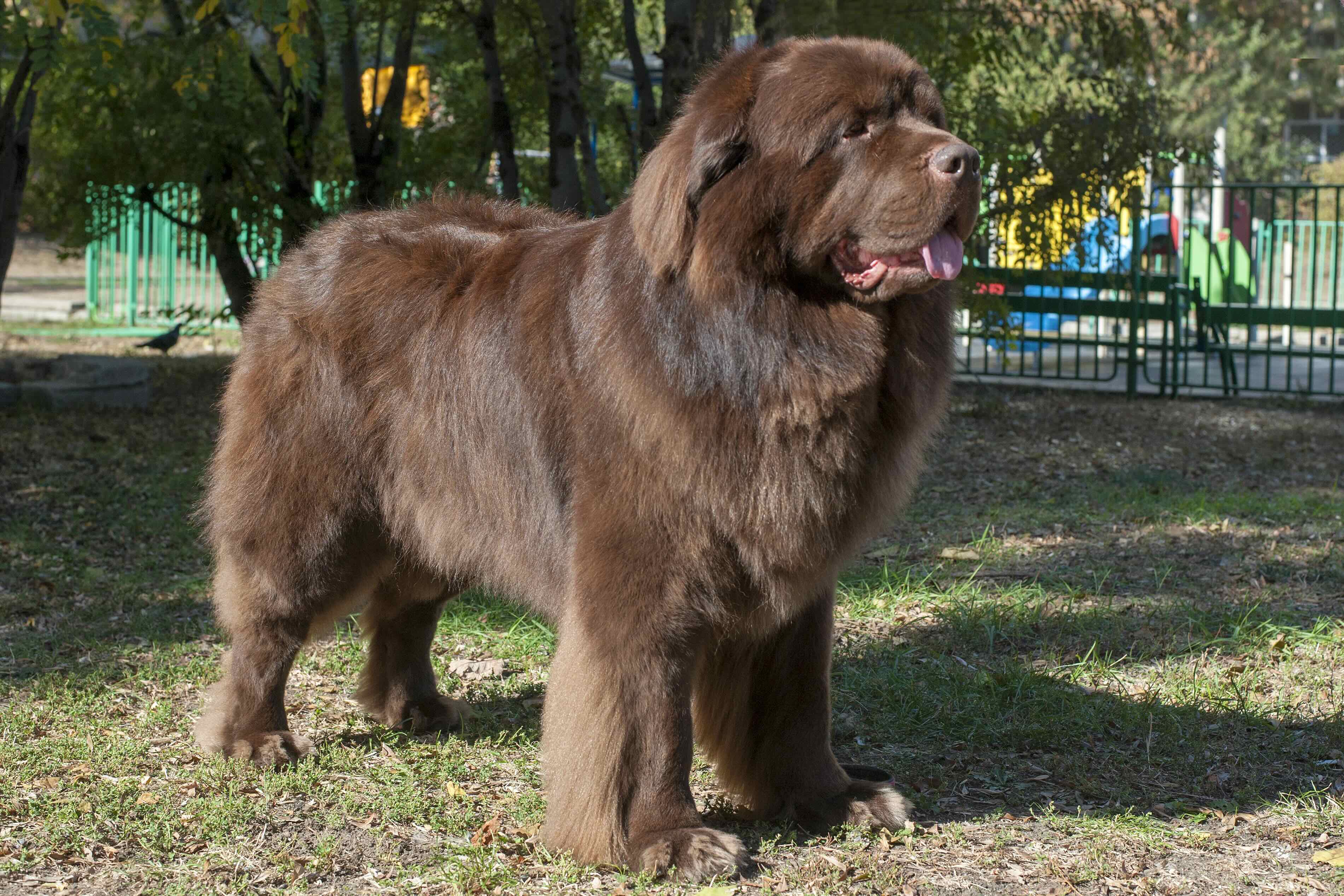Newfoundland
SvetaElfimova/iStock / Getty Images Plus via Getty Images
Newfoundlands, affectionately known as Newfies, are not only one of the biggest dog breeds, but they’re also one of the most docile and friendly.
The breed originated in Newfoundland, Canada, where the dogs worked alongside fishermen and served as water rescue dogs. Because of this history, Newfoundlands are natural swimmers—their webbed paws allow them to cut through water, and their thick coat insulates them from frigid temperatures.
You can still find working Newfoundland dogs today, but they also make a great family pet for those with enough space to house this gentle giant.
Caring for a Newfoundland

At 100–150 pounds, a full-grown Newfoundland dog weighs as much as some humans. They also stand about 26–28 inches tall at the shoulder, have a thick double coat that sheds year-round, and tend to drool. Put all this together and you have a supersized dog that needs consistent upkeep.
For pet parents dedicated to brushing their dog and wiping away drool, Newfoundlands reward you with their sweet temperament. These friendly dogs have a reputation for being calm at home, patient around children, and good roommates to other dogs and cats.
Newfoundland Health Issues

The average Newfoundland dog lifespan is 9–10 years. While they’re a generally healthy breed, the Newfoundland’s size and genetics makes them susceptible to certain health conditions pet parents need to be aware of.
Gastric Dilatation-Volvulus (GDV)
Gastric dilatation-volvulus, a severe form of bloat in dogs, is a condition that occurs suddenly and requires immediate life-saving veterinary attention.
GDV happens when the stomach fills up with food or gas, causing the stomach to expand. The stomach can then rotate, which causes inadequate blood supply to the spleen and stomach.
Symptoms include:
-
Non-productive retching
-
Swollen abdomen
-
Pacing and an inability to settle
-
Collapse
Without quick veterinary care, a dog can experience shock, tissue damage, and even death. Take your Newfoundland to the nearest emergency vet immediately if you notice any symptoms of bloat and GDV. The longer a dog has this condition without intervention, the greater the risk of death.
Increased risk is seen in older dogs with a deep chest, like the Newfoundland. To prevent GDV, a gastropexy procedure can secure the stomach to prevent it from twisting. This is often done at the same time as the dog’s spay or neuter surgery.
Bone Cancer (Osteosarcoma)
Osteosarcoma is an aggressive bone cancer Newfoundland dogs are predisposed to. This is the most common type of bone tumor found in dogs, especially larger breeds like Newfies.
The first symptom that is noted is usually lameness or limping, and a vet will take X-rays to diagnose osteosarcoma. Treatment often includes pain control, amputation, and chemotherapy.
Hip Dysplasia
Hip dysplasia is a condition where the hip joint doesn’t develop properly, causing a loose joint. This can be influenced by growth rate, hormones, or diet, and it can lead to degenerative joint disease and osteoarthritis. This arthritis leads to pain, limping, and difficulty standing.
Maintaining a lean body condition is important for preventing arthritis. Many vets recommend low-intensity exercise, omega-3 fatty acids (fish oil), and joint supplements for dogs diagnosed with hip dysplasia. In severe cases, surgery may be needed.
Elbow Dysplasia
Elbow dysplasia is a condition where the elbow joint develops abnormally. This is usually influenced by genetics, abnormal/rapid growth, diet, or trauma.
The condition can cause pain, limping, and (like hip dysplasia) arthritis. Treatment of elbow dysplasia varies based on the severity, but surgery is required in most cases.
Dilated Cardiomyopathy (DCM)
Dilated cardiomyopathy (DCM) is degeneration of the heart that causes the muscle of the left ventricle to become very thin and pump weakly. The symptoms (including rapid breathing, lethargy, and a decreased appetite) may occur suddenly or progress gradually as the disease worsens over time, and it can eventually lead to congestive heart failure.
DCM is a very serious condition that requires intensive treatment, and not all dogs will return to normal.
What To Feed a Newfoundland

Feeding commercial kibble or wet food that's compliant with the Association of American Feed Control Officials (AAFCO) standards is a good way to make sure your Newfie receives a complete and balanced diet.
To maintain a healthy growth rate in Newfoundland puppies, they need to get the proper amounts of fat, protein, and carbohydrates. Newfie puppies can get all of their nutrition through AAFCO-compliant puppy foods designed for giant and large-breed dogs.
Talk to your vet about the best dog food for your Newfoundland.
How To Feed a Newfoundland
Adult Newfies do best if fed about every 12 hours. A Newfoundland puppy may benefit from more frequent meals, so talk to your vet about the best feeding schedule for your dog.
Because Newfoundland dogs are at risk of bloat and GDV, pet parents should take steps to reduce the chances of these conditions by:
-
Helping their Newfoundland eat more slowly by using slow feeder bowls, lick mats, or puzzle feeders
-
Avoiding raised food bowls, which may increase the chance of bloat
-
Feeding their dog at least twice a day instead of one big meal
-
Avoiding exercising their dog an hour before or after a meal
How Much Should You Feed a Newfoundland?
As with humans, the recommended caloric intake required varies between dogs depending on their size, metabolism, and activity level. The best way to determine how much to feed your Newfoundland is to talk with your veterinarian and consult the feeding guide labels on your chosen dog food.
Nutritional Tips for Newfoundlands
Healthy, full-grown Newfoundland dogs eating an AAFCO-compliant diet should receive all needed nutrients. However, your vet may recommend certain supplements for your dog based on their specific needs.
Never give your dog a supplement without speaking with your veterinarian first.
Behavior and Training Tips for Newfoundlands
Newfoundland Personality and Temperament

A Newfoundland dog’s personality makes the breed an outstanding family pet. They have a sweet disposition and gentle nature, so Newfies get along well with children, small pets, and other dogs.
But just like with all dogs, supervise all interactions between small kids and Newfoundlands. Newfies are gentle, but they’re big and might accidentally knock over a young child.
Newfoundlands are calm dogs that don’t need an excessive amount of exercise—but this doesn’t mean no exercise. Take your Newfoundland on daily walks, occasional hikes, or for a swim to provide mental stimulation and prevent obesity.
Newfoundland Behavior
Because Newfoundland dogs are so loving, some may develop separation anxiety when left alone. You can help a dog with separation anxiety by providing them with enough exercise and mental stimulation when you’re together and by leaving interactive toys with your Newfie when you’re gone.
Talk to your vet if your dog experiences separation anxiety. They can give you specific advice on how to help.
Newfoundland dogs often pull on their leash; early leash training will help prevent this.
Newfoundland Training
When bringing home a Newfoundland puppy, know that they won’t stay small for long. Newfoundland puppies grow quickly, to the point where they can overpower their human parents with pulling or jumping. Early and consistent obedience training is a must.
But Newfies are smart dogs, which allows for successful training. Some can be strong-willed, but training will be successful when based on positive reinforcement with lots of rewards for good behavior.
All dogs, even the friendly Newfoundland, need consistent socialization as puppies to help them be comfortable, confident, and well-behaved in different situations. Talk to your vet for advice on how to best socialize your Newfoundland puppy.
Fun Activities for Newfoundlands
Newfoundland Grooming Guide

The Newfoundland has a double coat: coarse and water-resistant on top with a soft, dense undercoat. This coat comes in a few different colors—you’ll find black, black and white, gray, and brown Newfoundland dogs.
Newfies shed year-round but usually “blow their coat” twice a year, when the shedding is extra heavy. Consistent care is needed to maintain a healthy coat, but extensive grooming and professional appointments aren’t necessary.
Skin Care
Newfoundland dogs do best if bathed roughly once a month, but never more than once every two weeks. Bathe them after they’ve been swimming using a dog-friendly shampoo.
Coat Care
The Newfie’s long, coarse coat requires thorough brushing at least once a week to prevent matting and remove dead hair. Brushing will also help limit the amount of fur that ends up on your furniture.
Pet parents will also need to regularly wipe their Newfie’s drool, which can get caught in their fur.
Eye Care
There are no special eye care needs for the Newfie. If a small amount of debris collects around the eyes, it can be cleaned with a soft, moist cloth or vet-recommended eye cleaner.
Excess eye discharge, squinting, cloudiness, and/or redness can be signs of more serious eye conditions that warrant a vet exam.
Ear Care
The Newfoundland’s floppy ears can easily trap debris and moisture, leading to ear infections. To prevent infections, clean your dog’s ears at your vet’s recommendation with a pet-specific ear cleaner.
Considerations for Pet Parents

The Newfie’s sweet temperament makes them an excellent dog for families. Early positive reinforcement training and socialization are necessary due to their large size. They have a moderate energy level and do well when given a fun activity to stimulate their mind and body.
But take note: Newfies shed a lot and drool even more, so having a strong vacuum and a towel on hand is encouraged.
Newfoundland FAQs
How big are Newfoundland dogs?
A full-grown Newfoundland dog’s size is 26–28 inches tall and weighs 100–150 pounds.
How long do Newfoundlands live?
The average Newfoundland lifespan is 9–10 years.
How much does a Newfoundland cost?
The average Newfoundland dog price varies on many different factors, but you can expect to pay $1,500–$2,000 for a Newfie puppy from a breeder. You can also find Newfoundlands for adoption at shelters and breed-specific rescues.
Is a Newfoundland a good family dog?
Yes. When well-socialized and trained at a young age, the Newfie makes an excellent family pet—if you don’t mind some slobber. They have a gentle temperament and intelligent nature.
Do Newfoundlands bark a lot?
All dogs bark, but Newfoundlands don’t have a reputation for excessive barking. They may bark to alert their pet parents.
